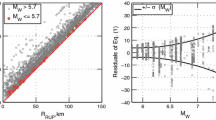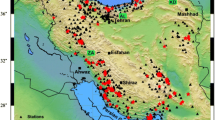Abstract
A new set of empirical equations for prediction of displacement response spectral ordinates from 20 Hz to T = 20 s is illustrated. The coefficients of the equations were obtained by regressing a dataset based on 1,155 tri-axial digital and 9 analog accelerometer records from 60 earthquakes worldwide. Long period disturbances in the accelerograms were evaluated and removed using a very recent method, aimed at preserving the long-period spectral content of the records. Analysis of variance has disclosed only little evidence for regional dependence of ground motions, while a carefully conducted evaluation of site effects resulted in clearly differentiated spectral amplification bands associated to the main ground types B, C, and D of Eurocode 8. Spectral ordinates for vibration periods >5 s were found to scale with magnitude quite consistently with theoretical scaling from Brune’s model. On the other hand, comparison of results with those yielded by recent prediction models in Europe and the United States (NGA), indicated that the latter may not be uniformly reliable at long periods. The proposed empirical equations are easily implemented in computer programs for seismic hazard assessment, being characterized by a simple functional form and a restricted number of predictor variables.
Similar content being viewed by others
References
Akkar S, Bommer JJ (2006) Influence of long-period filter cut-off on elastic spectral displacements. Earthquake Eng Struct Dyn 35:1145–1165
Akkar S, Bommer JJ (2007a) Prediction of elastic displacement response spectra in Europe and the Middle East. Earthquake Eng Struct Dyn 36(10):1275–1301
Akkar S, Bommer JJ (2007b) Empirical prediction equations for peak ground velocity derived from strong-motion records from Europe and the Middle East. Bull Seism Soc Am 97(2):511–530
Ambraseys N, Smit P, Sigbjornsson R, Suhadolc P, Margaris B (2002) Internet-site for European strong-motion data. European Commission, Research-Directorate General, Environment and Climate Programme, www.isesd.cv.ic.ac.uk/ESD
Ambraseys NN, Douglas J, Sarma SK, Smit PM (2005) Equations for the estimation of strong ground motions from shallow crustal earthquakes using data from Europe and the Middle East: horizontal peak ground acceleration and spectral acceleration. Bull Earthq Eng 3:1–53
Berge-Thierry C, Cotton F, Scotti O, Griot-Pomniera DA, Fukushima Y (2003) New empirical spectral response attenuation laws for moderate European earthquakes. J Earthq Eng 7(2):193–222
Bommer JJ, Douglas J, Strasser FO (2003) Style-of-faulting in ground-motion prediction equations. Bull Earthq Eng 1:171–203
Bommer JJ, Stafford PJ, Alarcón JE, Akkar S (2007) The influence of magnitude range on empirical ground-motion prediction. Bull Seism Soc Am 97(6):2152–2170
Boore DM (2001) Effect of baseline corrections on displacements and response spectra for several recordings of the 1999 Chi-Chi, Taiwan, earthquake. Bull Seismol Soc Am 91(5):1199–1211
Boore DM (2004) Estimating VS(30) (or NEHRP site classes) from shallow velocity models (depths <30 m). Bull Seismol Soc Am 94(2):591–597
Boore DM (2005) On pads and filters: processing strong-motion data. Bull Seismol Soc Am 95(2):745–750
Boore DM, Joyner WB, Fumal TE (1994) Estimation of response spectra and peak accelerations from Western North American earthquakes: an interim report—part 2. USGS open-file report 94–127
Boore DM, Joyner WB, Fumal TE (1997) Equations for estimating horizontal response spectra and peak acceleration from Western North American earthquakes: a summary of recent work. Seismol Res Lett 68(1):128–153
Boore DM, Stephens CD, Joyner WB (2002) Comment on baseline correction of digital strong-motion data: examples from the 1999 Hector Mine, California, earthquake. Bull Seismol Soc Am 92(4):1543–1560
Boore DM, Bommer JJ (2005) Processing of strong-motion accelerograms: needs, options and consequences. Soil Dyn Earthqu Eng 25(2005):93–115
Boore DM, Watson-Lamprey J, Abrahamson NA (2006) GMRotD and GMRotI: orientation-independent measures of ground motion. Bull Seismol Soc Am 96:1502–1511
Boore DM, Atkinson GM (2007) Boore-Atkinson NGA ground motion relations for the geometric mean horizontal component of peak and spectral ground motion parameters, PEER 2007/01, Pacific Earthquake Engineering Research Center, Berkeley, California
Boore DM, Atkinson GM (in press) Ground-motion prediction equations for the average horizontal component of PGA, PGV, and 5%-damped PSA at spectral periods between 0.01 s and 10.0 s. Earthq Spectra
Brune JN (1970) Tectonic stress and the spectra of seismic shear waves. J Geophys Res 75:4997–5009
BSSC, Building Seismic Safety Council (2003) The 2003 NEHRP Recommended provisions for new buildings and other structures. Part 1: provisions (FEMA 450), www.bssconline.org
Campbell KW, Bozorgnia Y (2007) Campbell-Bozorgnia NGA ground motion relations for the geometric mean horizontal component of peak and spectral ground motion parameters, PEER 2007/02, Pacific Earthquake Engineering Research Center, Berkeley, California
CEN, European Committee for Standardization (2004) Eurocode 8: design of structures for earthquake resistance—part 1: general rules, seismic actions and rules for buildings. Bruxelles
Choi Y, Stewart JP (2005) Nonlinear site amplification as a function of 30 m shear wave velocity. Earthq Spectra 21(1):1–30
Converse AM, Brady AG (1992) BAP: basic strong-motion accelerogram processing software, version 1.0. USGS Open-File Rept. 92-296A, 174 pp
Douglas J (2003) Earthquake ground motion estimation using strong-motion records: a review of the equations for the estimation of peak ground acceleration and response spectral ordinates. Earth-Sci Rev 61:43–104
Douglas J (2004a) An investigation of analysis of variance as a tool for exploring regional differences in strong ground motions. J Seismol 8:485–496
Douglas J (2004b) Use of analysis of variance as a tool for the investigation of regional dependence of strong ground motions. In: Proceedings of the13th World Conference on Earthquake Engineering, Vancouver, B. C., Canada, Paper no. 29
Douglas J (2007) On the regional dependence of earthquake response spectra. ISET J Earthq Technol 44(1):71–99
Douglas J, Smit PM (2001) How accurate can strong ground motion attenuation relations be? Bull Seismol Soc Am 91(6):1917–1923
Draper NR, Smith H (1981) Applied regression analysis, 2nd edn. Wiley, New York
Faccioli E, Paolucci R, Rey J (2004) Displacement spectra for long periods. Earthq Spectra 20:347–376
Faccioli E, Cauzzi C, Paolucci R, Vanini M, Villani M, Finazzi D (2007) Long period strong ground motion and its use as input to displacement based design. In: Pitilakis K (ed) Earthquake geotechnical engineering. 4th International Conference on Earthquake Geotechnical Engineering—Invited Lectures. Springer Netherlands
Figini R (2006) Analisi degli effetti di sito sui lunghi periodi degli spettri di risposta di spostamento. Master’s Thesis, Politecnico di Milano
Fletcher JB, Baker LM, Spudich P, Goldstein P, Sims JD, Hellweg M (1992) The USGS Parkfield, California, dense seismograph array: UPSAR. Bull Seismol Soc Am 82:1041–1070
Fletcher JB, Spudich P, Baker LM (2006) Rupture propagation of the 2004 Parkfield, California, earthquake from observations at UPSAR. Bull Seismol Soc Am 96(4B):S129–S142
Fukushima Y, Tanaka T (1990) A new attenuation relation for peak horizontal acceleration of strong earthquake ground motion in Japan. Bull Seismol Soc Am 80(4):757–783
Gruppo di lavoro CPTI (2004) Catalogo Parametrico dei Terremoti Italiani, versione 2004 (CPTI04). Istituto Nazionale di Geofisica e Vulcanologia (INGV), Bologna, emidius.mi.ingv.it/CPTI
Halldórsson B, Ólafsson S, Sigbjörnsson R (2007) A fast and efficient simulation of the far-fault and near-fault earthquake ground motions associated with the June 17 and 21, 2000, earthquakes in South Iceland. J Earthq Eng 11:343–370
Jangid RS, Kelly JM (2001) Base isolation for near-fault motions. Earthquake Eng Struct Dyn 30(5):691–707
Japanese Working Group on Effects of Surface Geology on Seismic Motion, Association for Earthquake Disaster Prevention (1998) CD-ROM for the Kobe simultaneous simulation, distributed to participants to the experiment. Proc. of the 2nd International Symposium on the Effects of Surface Geology on Earthquake Ground Motion, Yokohama, Japan
Jousset P, Douglas J (2007) Long-period earthquake ground displacements recorded on Guadeloupe (French Antilles). Earthquake Eng Struct Dyn 36(7):949–963
Joyner WB, Boore DM (1981) Peak horizontal acceleration and velocity from strong-motion records including records from the 1979 Imperial Valley, California, earthquake. Bull Seismol Soc Am 71(6):2011–2038
Joyner WB, Boore DM (1993) Methods for regression analysis of strong-motion data. Bull Seismol Soc Am 83(2):469–487
Joyner WB, Boore DM (1994) Errata: methods for regression analysis of strong-motion data. Bull Seismol Soc Am 84:955–956
Paolucci R, Rovelli A, Faccioli E, Cauzzi C, Finazzi D, Vanini M, Di Alessandro C, Calderoni G (2008) On the reliability of long period spectral ordinates from digital accelerograms. Earthquake Engng Struct Dyn 2008(37):697–710
Park R, Paulay T (1976) Reinforced concrete structures. Wiley, New York
PEER, Pacific Earthquake Engineering Research Center (2007) Next generation attenuation of ground motions (NGA) project. Web site: peer.berkeley.edu/products/nga_project.html
Pousse G, Berge-Thierry C, Bonilla F, Bard PY (2005) Eurocode 8 design response spectra evaluation using the K-Net Japanese database. J Earthq Eng 9(4):547–574
Priestley MJN, Calvi GM, Kowalsky MJ (2007) Displacement-based seismic design of structures. IUSS, Pavia
Rathje EM, Stewart JP, Bora Baturay M, Bray JD, Bardet JP (2006) Strong ground motions and damage patterns from the 1999 Duzce earthquake in Turkey. J Earthq Eng 10(5):693–724
Rey J, Faccioli E, Bommer J (2002) Derivation of design soil coefficients (S) and response spectral shapes for Eurocode 8 using the European strong motion database. J Seismol 6(4):547–555
Spudich P, Joyner WB, Lindh AG, Boore DM, Margaris DM, Fletcher JB (1999) SEA99: a revised ground motion prediction relation for use in extensional tectonic regimes. Bull Seismol Soc Am 89(5):1156–1170
Stafford PJ, Strasser FO, Bommer JJ (2008) An evaluation of the applicability of the NGA models to ground-motion prediction in the Euro-Mediterranean Region. Bull Earthq Eng DOI 10.1007/s10518-007-9053-2
Wang GQ, Boore DM, Tang G, Zhou X (2007) Comparisons of ground motions from colocated and closely spaced one-sample-per-second global positioning system and accelerograph recordings of the 2003 M 6.5 San Simeon, California, earthquake in the Parkfield region. Bull Seismol Soc Am 97(1B):76–90
Wells DL, Coppersmith KJ (1994) New empirical relationships among magnitude, rupture length, rupture width, rupture area, and surface displacement. Bull Seismol Soc Am 84:974–1002
Westaway R, Smith RB (1989) Strong ground motion in normal-faulting earthquakes. Geophys J 96:529–559
Zaré M (2004) Long period Iranian strong motions recorded during 1994–2002, processing and analysis. In: Proceedings of the13th World Conference on Earthquake Engineering, Vancouver, B. C., Canada, Paper no. 2002
Zhao JX, Irikura K, Zhang J, Fukushima Y, Somerville PG, Asano A, Ohno Y, Oouchi T, Takahashi T, Ogawa H (2006) An empirical site-classification method for strong-motion stations in Japan using H/V response spectral ratio. Bull Seismol Soc Am 96:914–925
Author information
Authors and Affiliations
Corresponding author
Electronic supplementary material
Below is the link to the electronic supplementary material.
ESM 1
(XLS 587 KB)
Rights and permissions
About this article
Cite this article
Cauzzi, C., Faccioli, E. Broadband (0.05 to 20 s) prediction of displacement response spectra based on worldwide digital records. J Seismol 12, 453–475 (2008). https://doi.org/10.1007/s10950-008-9098-y
Received:
Accepted:
Published:
Issue Date:
DOI: https://doi.org/10.1007/s10950-008-9098-y




